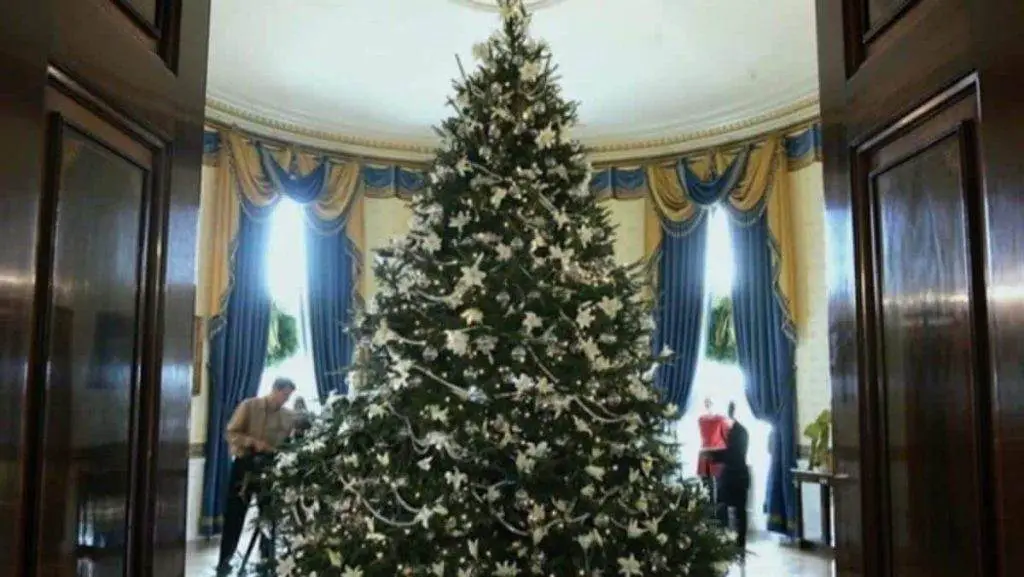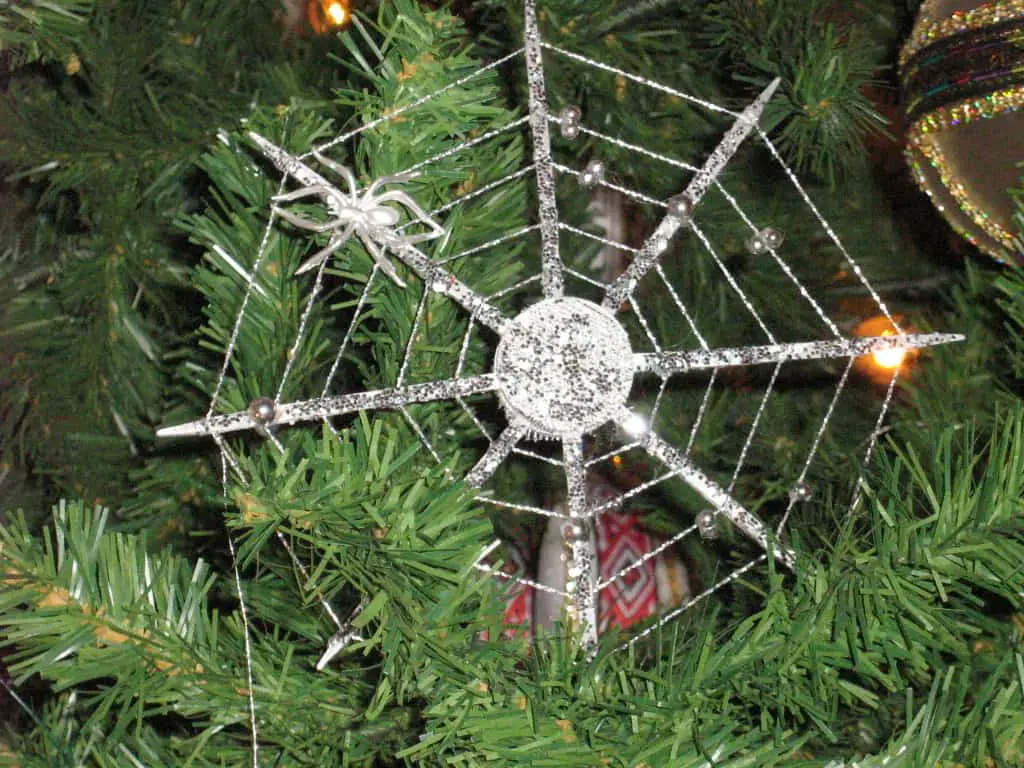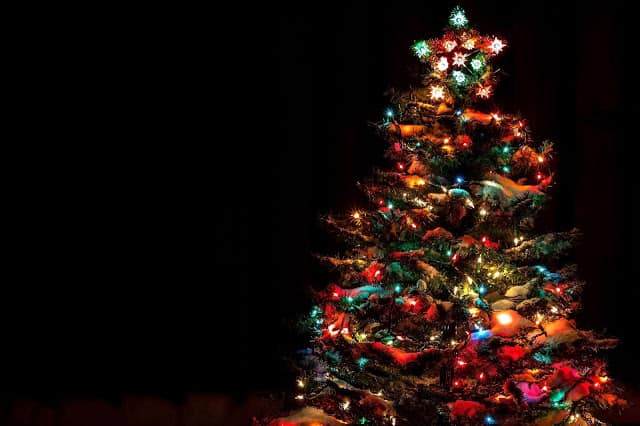The decorating of Christmas trees originated in 16th century Germany, where Christians would bring decorated trees into their homes on Christmas Eve. The first recorded tree was set up by German Protestant reformer Martin Luther, who reportedly decorated a small evergreen with candles to show his children how the night sky looked on the night of Christ’s birth. The Christmas tree tradition quickly spread to other German states and principalities.
The decorated paradise tree, as it was known, was brought to America by German immigrants in the early 19th century. The custom grew popular in England during the reign of Queen Victoria after her German husband Prince Albert set up a Christmas tree at Windsor Castle.
By the 1890s, creating a Christmas tree had become common in American homes. As soon as electricity became widespread, Christmas lights illuminated the ornament-bedecked trees.
Over time, various types of real trees gave way to artificial trees made from wire, feathers, or brush bristles. In the 1930s, the Addis Brush Company created an artificial brush tree from machinery manufacturing toilet brushes!
Today, Americans continue decorating evergreen Christmas trees, whether real or fake, with shiny ornaments, garlands, tinsel, and twinkling lights. The Christmas tree remains a centrepiece of Christmas celebrations, symbolic of gathering with friends and family during the holiday season.
How Xmas Trees Came into Existence
Evidence suggests that some poorer families stacked pieces of wood together to form makeshift Christmas trees.
- Pagan Roots: The use of evergreen trees in winter celebrations dates back to ancient times. Many cultures, including the Egyptians, Romans, and Celts, revered evergreen trees as symbols of life and fertility. They remained green and vibrant throughout the winter when other trees shed their leaves.
- Medieval Germany: The tradition of decorating trees during Christmas is associated with Germany in the Middle Ages. Some accounts suggest that Germans would bring evergreen trees into their homes and decorate them with candles to symbolize light during the dark winter.
- Martin Luther and the Protestant Reformation: Legend has it that Martin Luther, the 16th-century Protestant reformer, was inspired by the beauty of stars shining through evergreen trees. In the early 16th century, he is said to have added candles to a tree to recreate the scene, contributing to the tradition of Christmas tree lights.
- Introduction to England: The tradition of Christmas trees was introduced to England in the 18th century through the German-born wife of King George III, Queen Charlotte. However, the practice did not become widespread in England at that time.
- Prince Albert and Queen Victoria: The popularity of Christmas trees in England and, later, in the United States increased significantly during the 19th century. Prince Albert, Queen Victoria’s German husband, is credited with popularizing the Christmas tree in Britain. In 1848, an illustration of the royal family celebrating around a Christmas tree was published, further promoting the tradition.
- 19th-Century America: German immigrants brought the Christmas tree tradition to America in the 19th century. German settlers in Pennsylvania set up the first recorded Christmas tree in the United States in the 1830s. However, the custom did not become widespread until the mid-19th century.
- Commercialization and Modern Traditions: With time, the decoration of Christmas trees became more elaborate, incorporating a variety of ornaments, lights, and garlands. The commercialization of Christmas and the influence of popular culture and literature further solidified the Christmas tree as a central element of holiday celebrations.
Today, the Christmas tree is a widely embraced symbol of the holiday season, with various cultures and families incorporating their own traditions and decorations. The practice has evolved over the centuries, blending historical, religious, and cultural influences into our festive tradition.

Evidence of Christmas Trees
To find the first written evidence of Christmas trees, we must return to 1441. Or 1510, depending on which historian you believe.
There is still dispute over whether Tallinn, in Estonia, lays claim to the first Christmas tree or whether it’s Riga, in Latvia.
Documentary evidence shows both cities claim to have invented the Christmas tree. Interestingly, the people responsible were probably the same in both cases.
The Brotherhood of Blackheads, a group of unmarried seafarers, traders and foreigners, are thought to have erected trees in town squares.
We don’t have a lot of information about these events. However, the trees were likely danced around and then set on fire as part of Christmas celebrations.
It should be noted we don’t know if these ‘trees’ were trees as we’d expect. They may have been large wooden masts, or bigger versions of the timber-filled Paradise Trees used on Adam and Eve’s Day.
This may be where our fascination with the fir tree, particularly, and its zig -is pulled through the streets of a German town.
The man riding behind it is thought to represent St. Nicholas. In 1584, the historian Balthasar Russow described a Latvian custom of decorating fir trees, erecting them in town squares and setting them alight.
The tree would be set on fire after many hours of merriment, dancing, and japery.
Christmas Tree in Modern Times
The Christmas tree remains an integral part of holiday celebrations today. While traditionally topped with an angel or star, now anything goes – from snowflakes to Pokemon to the Grinch. Homes showcase trees lit with strands of sparkling LEDs or classic incandescent lights adorned with treasured handmade and customized ornaments.
The cutting down of fir, spruce, and pine trees to decorate for Christmas has shifted toward artificial trees and replanting efforts. High-quality artificial trees replicate the real look with lifelike branches and pine needles. More families opt for these reusable imitations due to convenience, especially in cramped city living spaces.
Those choosing fresh-cut trees try to purchase from local sustainable farms. Some communities sponsor tree recycling to mulch and reuse next season.
Beyond private homes, public Christmas trees, both grand and modest, bring the community together. Iconic massive evergreens tower over retail areas like New York’s Rockefeller Center. Small-town squares feature towering firs with handmade decorations lovingly placed by volunteer committees and donated by residents.
On Christmas Eve, carolers young and old, gather around these public trees to sing classics like “O Tannenbaum” and spread holiday cheer. Whether real or fake, indoors or out, the festively decorated trees keep old customs alive while allowing for joyful, creative new expressions. The beloved tradition continues to light up the season and bring people together.
Tinsel and the Legend of the Christmas Spider
Nestled amidst the festive traditions and shimmering adornments of the Christmas season, there lies a heartwarming tale that weaves together the delicate threads of tinsel and the gentle spirit of a tiny spider. This enchanting legend, originating from Eastern Europe, has been passed down through generations, adding a touch of magic and wonder to the joyous preparations for Christmas.
A Widow’s Humble Christmas Wish
Once upon a time, a poor widow and her young children lived in a small, snow-dusted village. As Christmas approached, the widow’s heart sank with the weight of her meager means. She longed to decorate their humble home with the festive spirit of the season, but her pockets were empty.
A Spider’s Secret Wish
High above in the rafters of their home, a tiny spider named Tinsel had been observing the widow’s silent struggles. Tinsel, with his eight nimble legs and a heart full of compassion, yearned to bring joy to the widow and her children. He had always admired the beautiful Christmas decorations, especially the shimmering tinsel that adorned the trees in the village square.
A Night of Magical Transformation
On the eve of Christmas, as the widow and her children slept, Tinsel quietly descended from his hiding spot. With his tiny legs, he began to spin a delicate web, carefully weaving it across the branches of their Christmas tree. As he worked, the moonlight danced upon his web, transforming it into a shimmering cascade of silver and gold.
A Morning of Joy and Surprise
When the first rays of Christmas morning peeked through the window, the widow awoke to a sight that filled her heart with wonder. Her humble, bare and unadorned Christmas tree now sparkled with a magical glow. Thousands of shimmering strands of silver and gold cascaded down its branches, creating a spectacle of beauty that surpassed her wildest dreams.

The Gift of Gratitude and the Birth of a Tradition
Overwhelmed with emotion, the widow gathered her children, and together they marvelled at the enchanting transformation of their Christmas tree. They realized that this was no ordinary decoration; it was a gift of love and kindness, a testament to the generosity of a tiny spider named Tinsel.
From that day forward, the widow and her children cherished the memory of Tinsel’s gift. They decorated their Christmas tree with the utmost care, always leaving a special spot for the delicate webs that Tinsel spun each year. And so, the tradition of hanging tinsel on Christmas trees was born, a symbol of gratitude, hope, and the magic that can unfold in the most unexpected places.
The Enduring Legacy of Tinsel and the Christmas Spider
The legend of Tinsel and the Christmas Spider has become a cherished part of Christmas folklore, reminding us that the season’s true spirit lies not in material possessions but in the kindness, generosity, and magic that can be found even in the smallest creatures. As we adorn our Christmas trees with shimmering tinsel, let us remember the humble spider who inspired this tradition, and let our hearts be filled with the same spirit of compassion and the joy of giving.
Christmas Tree Lights

Origins and Candles on Trees
The tradition of placing candles on Christmas trees has roots in 16th-century Germany. Associated with Martin Luther, who added candles to a tree to mimic starlight. Wealthier families in Germany started decorating trees with candles in the 18th century, using wax or pins to attach them.
Fire Hazards and Challenges
Despite the enchanting effect, open flames on Christmas trees posed significant fire hazards. However, the tradition persisted in the 18th and 19th centuries, highlighting the challenges of balancing tradition with safety.
Introduction to England
Queen Charlotte, the German-born wife of King George III, introduced the Christmas tree tradition to England in the 18th century. Following the German tradition, candles were initially used for illumination on these trees in England.
19th Century and Widespread Adoption
The 19th century witnessed the widespread adoption of Christmas trees in various parts of the world. German immigrants brought the tradition to the United States, where it gained popularity in the mid-19th century.
Evolution and Commercialization
As the Christmas tree tradition evolved, so did the methods of illumination. Advances in technology and safety concerns led to the development of electric Christmas lights in the late 19th and early 20th centuries.
Introduction of Electric Christmas Lights
The first known use of electric Christmas lights dates back to the late 19th century. This innovation revolutionized tree decoration, providing a safer alternative to open flames and paving the way for the dazzling array of lights on Christmas trees today.
Incandescent lights: These are the traditional type of Christmas tree light. They are small, bright, and emit a warm, yellow light. However, they are not as energy-efficient as other lights and can get hot, so they are not as safe to use around children and pets.
LED lights: LED lights are a more energy-efficient and safer alternative to incandescent lights. They are also available in various colors: white, blue, green, red, and purple.
Mini lights: Mini lights are the smallest type of Christmas tree light. They are perfect for trees with small branches, or for creating a more delicate look.
C7 lights: C7 lights are larger than mini lights but still smaller than incandescent lights. They are a good choice for trees with larger branches, or for creating a more dramatic look.
Rope lights: Rope lights are a Christmas tree light strung on a wire. They are perfect for outlining the edges of a tree, or for creating a more dramatic look.
Net lights: Net lights are a type of Christmas tree light pre-strung on a net. They are perfect for covering large areas quickly and easily.
Christmas Tree Fun Facts

- The tradition of decorating Christmas trees started in 16th century Germany when Christians would bring decorated trees into their homes on Christmas Eve. Martin Luther was the first to add lights to his tree to represent stars.
- Christmas trees were originally decorated with edibles like apples, nuts, pretzels, paper flowers, and candles. Tinsel originated in 1610 in Germany and was once made of real silver!
- President Franklin Pierce was the first U.S. President to place a Christmas tree in the White House in 1856. President Grover Cleveland strung the first electric lights on a White House tree in 1895.
- On average, it takes 7-10 years for a Christmas tree grower to mature their trees for harvest. Oregon, North Carolina, Michigan, Pennsylvania, Wisconsin, and Washington are the top Christmas tree-producing states.
- The best-selling artificial Christmas trees are pencil and sparking models. Over 75 million reusable fake trees are in use in North America alone.
- Christmas trees are edible! Many parts of firs, pines, and spruces are high in vitamin C – some folks make tree tip syrup or use the branches for cooking. Tree farmers feed their sheep fallen trees after the holidays.
- In 1912, the first community Christmas tree was lit in Madison Square Park in New York City. Today, lighting gigantic public trees like those at Rockefeller Center and the White House is a major annual celebration across America.
Learn More With the Help of Video
Main Points About History of Christmas Trees
- Originated in 16th century Germany when Christians brought decorated trees into homes on Christmas Eve
- Martin Luther was possibly the first to add lights to the tree to represent stars.
- Early decorations included edibles like fruits, nuts, paper, candles; tinsel originally made from real silver
- President Franklin Pierce placed the first Christmas tree in the White House in 1856
- President Grover Cleveland strung the first electric lights on White House tree in 1895
- On average, takes 7-10 years to mature Christmas trees for harvesting
- Top producing states today are Oregon, North Carolina, Michigan, Pennsylvania, Wisconsin, Washington
- Best-selling artificial trees today are pencil and sparking models; over 75 million fake trees in North America
- Christmas trees are edible! Fir, pine, spruce used for syrups, cooking, sheep feed after the holidays
- The first community Christmas tree was lit in 1912 in Madison Square Park, New York City
- The lighting of huge public trees like Rockefeller Center tree, a major annual celebration
Conclusion
The tradition of having a Xmas tree in the home and decorating it before Christmas is the traditional way to bring the spirit of Christmas to homes.
People across countries bring Christmas trees. Even in countries where Christianity is not the first religion, people do buy Christmas trees from the market. Without a Christmas tree, the decorations are never complete.
Word Cloud for History of Christmas Trees
The following is a collection of the most used terms in this article on the History of Christmas Trees. This should help you recall related terms as used in this article at a later stage.





